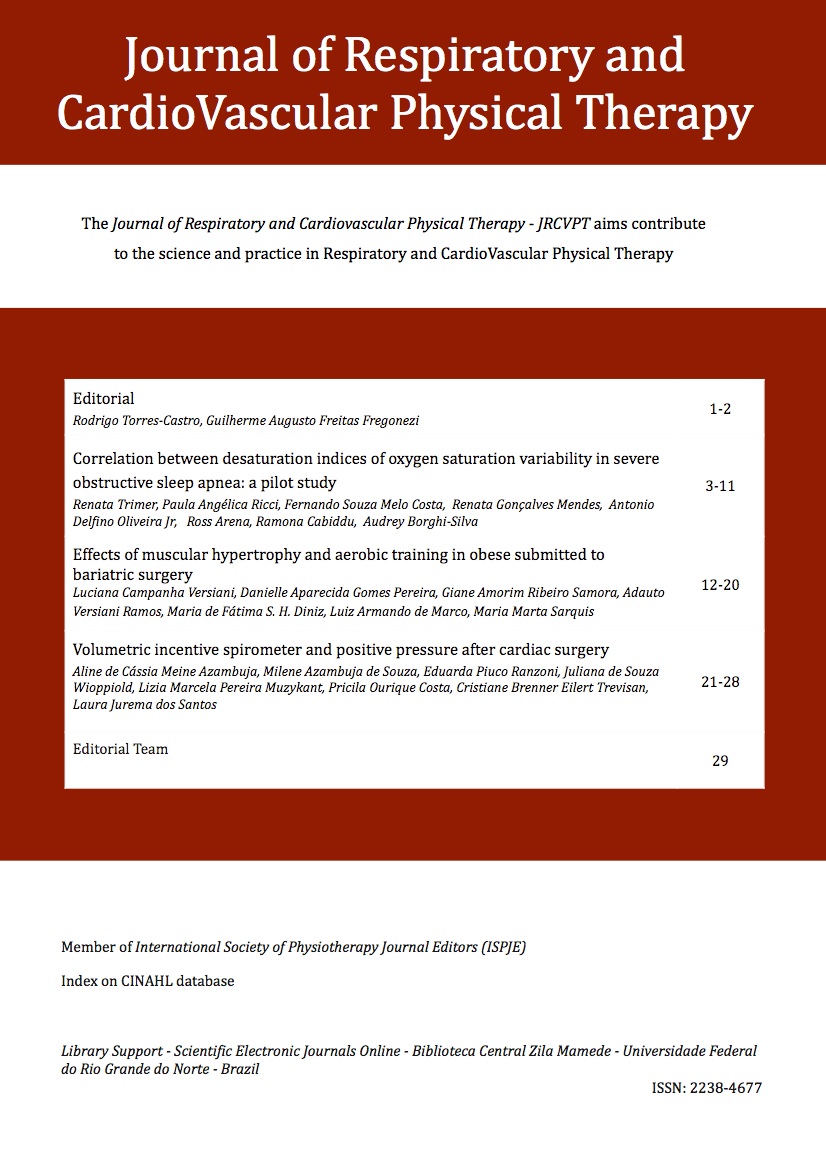Corralation between desaturation indices of oxygen saturation variability in severe obstructive sleep apnea: a pilot study
Palabras clave:
overnight polysomnography, pulse oximetry, OSA, oxygenation, sleep, saturationResumen
Background: Obstructive sleep apnea (OSA) is a respiratory disorder characterized by recurrent airflow obstruction caused by total or partial collapse of the upper airway. The aim of this study is to compare the accuracy of the different indices derived from pulse oximetry using free software in the diagnosis of severe OSA and to determine the relationship of these indices with the apnea-hypopnea index (AHI), cumulative time spent below 90% SpO2 (T90) and the oxygen desaturation event index (ODI).
Methods: Cross-sectional study with 20 untreated severe OSA patients and 11 subjects with AHI<5 referred to a sleep laboratory. The AHI, T90 and ODI indices were calculated from pulse oximetry simultaneously during polysomnography. To analyze variability of SpO2 in each pulse wave (SpO2V), interval of oxygen pulse wave (IOP) index, standard deviation of IOP (STDIOP), mean of oxygen saturation (MOS), root mean square of IOP standard deviation (SDIOP) of SpO2V were calculated.
Results: OSA subjects presented with higher values of IOP, STDIOP, SDIOP when compared to controls (p<0.05). The area under the ROC curve of IOP, STDIOP, SDIOP were 0.93, 0.99, and 0.99, respectively. T90 demonstrated a positive correlation with IOP (r=0.94), STDIOP (r=0.64) and SDIOP (r=0.73) as well as ODI with IOP (r=0.79), STDIOP(r=0.78), SDIOP (r=0.73) and AHI with STDIOP (r 0=76), SDIOP (r=0.73).
Conclusions: SpO2V was correlated with AHI, ODI and T90 indices and presented positive predictive value for OSA. The SpO2V could be useful and allows for a non-invasive widely applicable diagnostic technique for severe OSA.
Descargas
Descargas
Publicado
Cómo citar
Número
Sección
Licencia
Copyright Transfer Statement
The author(s) of the article, as specified here, hereby transfer(s) to the Revista de Fisioterapia Respirtória e CardioVascular (Journal of Respiratory and CardioVascular Physical Therapy) all copyright ownership rights, title and interests that the author(s) may have or may come to have in and to the article and any revision or version thereof, including, but not limited to, exclusive right to print, publish and sell the article anywhere in the world, in any language and in any media.
This agreement will be considered effective and valid if and when the article is accepted for publication.
If the article contains any copyright-protected material from a third party, the author(s) must obtain written permission to reproduce the said material in the article from the copyright holder and send it to the Revista de Fisioterapia Respirtória e CardioVascular (Journal of Respiratory and CardioVascular Physical Therapy).
The author(s) guarantee(s) the holding of proprietary rights to the article; not having granted or transferred any rights to the article to any other persons or entity; that the article is susceptible to the demand for rights by its author(s); not having infringed upon any author rights, trademark or patent; not having violated the right to privacy or publicity of any person or entity; that the article does not contain any defaming subject; that the factual statements made are true or are based on reasonably accurate research; and, finally, that, the author(s) has/have no reason to believe that any of the formulas, procedures or prescriptions contained in the article will cause damage if used or followed in accordance with the instructions and warnings contained in the article.
The author(s) will indemnify the Revista de Fisioterapia Respirtória e CardioVascular (Journal of Respiratory and CardioVascular Physical Therapy) against any costs, expenses, damages or liability that the Revista de Fisioterapia Respirtória e CardioVascular (Journal of Respiratory and CardioVascular Physical Therapy) may incur as a result of accidental omissions of these guarantees. These representations and guarantees may be extended to a third party by the Revista de Fisioterapia Respirtória e CardioVascular (Journal of Respiratory and CardioVascular Physical Therapy).
Date:
Note: Each author must individually complete and sign this form
1) Author:
Signature: _________________________________
2) Author:
Signature: _________________________________
3) Author:
Signature: _________________________________
4) Author:
Signature: _________________________________
5) Author:
Signature: _________________________________
6) Author:
Signature: _________________________________
7) Author:
Signature: _________________________________
8) Author:
Signature: _________________________________




 English
English Español (España)
Español (España) Português (Brasil)
Português (Brasil) Français (Canada)
Français (Canada)